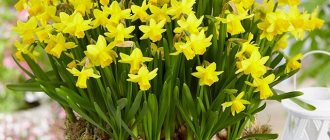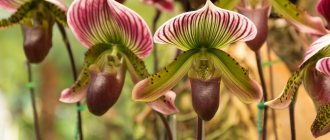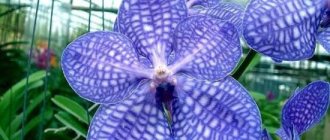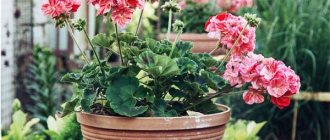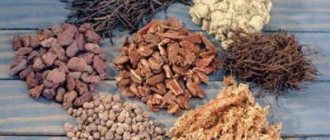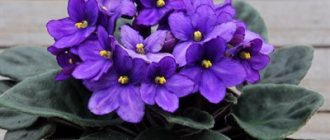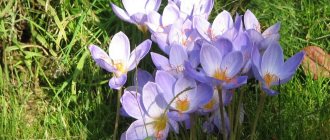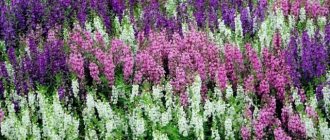Increasingly, flower growers are coming to the attention of representatives of lush tropical flora that are unusual for growing in home culture.
Many of them are distinguished by their fastidious nature and difficult requirements for growing conditions, which does not prevent their relocation from greenhouses and winter gardens to the window sills of city apartments.
One of the most spectacular tropical sissies can be called Medinilla, striking with its rich greenery and magnificent flowering.
Description of Medinilla
The Medinilla genus includes about four hundred evergreen tree and shrub forms and several species of herbaceous vines.
These are plants from the tropical forests of the Philippine Islands, also found in Australia, in the east of the African continent and in the southern regions of the Asian region. Interesting! The name of this flower was fixed in the second decade of the 19th century - the plant received its name in honor of the governor of the Mariana Islands, José de Medinilla y Pineda.
In their natural habitat, some species of Medinilla grow up to 3 m, in greenhouses these plants reach 2 m, and in home culture their height does not exceed 0.3 - 1.5 m.
The value of Medinilla lies in the fact that it retains its decorative appearance regardless of flowering . Strong stems of a greenish-brown tone bear voluminous whorled or opposite leaves of a dense, thickened, leathery structure.
Whole leaves of an elongated oval shape (within 30 cm) are distinguished by their juicy dark green color. Their lighter veining and slight concavity create the effect of a wavy graphic relief.
But the main thing, because of which flower growers are ready to endure all the hardships of growing Medinilla, is its grandiose inflorescences. In spring, large pyramidal buds of pink, salmon or lilac shades form in the leaf axils on drooping, elongated pedicels.
Each inflorescence consists of several tiers: under 2 - 3 rows of large wings of bracts with bright stripes, numerous rows of small, tubular or bell-shaped flowers with fluffy anthers on long stamens densely fall.
Origin, appearance of medinilla, difficulties of care
Medinilla is a typical representative of tropical flora. In nature, it lives in humid, warm African and Asian jungles, distributed on the islands of the Indian and Pacific Oceans: Madagascar, Sri Lanka, the Philippines and the Malay Archipelago. There are about 400 species of bushy plants and vines in the Medinilla genus. These evergreen shrubs often lead an epiphytic or semi-epiphytic lifestyle. That is, they are able to grow in complete or partial separation from the ground.
At home, Medinilla lives in the humid and warm atmosphere of the tropical forest.
The plant got its name in honor of the governor of the Spanish colony, de Medinilla.
Medinilla is the largest epiphytic shrub; in its natural environment its growth can be more than 2 meters. The ribbed or rounded shoots of most varieties are smooth, but may be slightly pubescent. The large oval leaves have well-drawn veins, they are lighter in color and seem to be depressed. The leaf blade is dense, harsh and naturally shiny.
All medinillas have bright, large foliage, but they are grown for their lovely inflorescences; they can be directed upward or drooping
But the main decoration of medinilla is its magnificent flower clusters. In spring or summer, flower stalks appear at the ends of the shoots. They consist of long (about 45 cm) paniculate racemes. Each holds many (up to fifty) initially small bell-shaped flowers, which, gradually blooming, acquire a star-shaped shape.
There are several dozen flowers on one brush
Their petals are soft pink, white, red, lilac or light purple, and the stamens are usually yellow. In the most decorative variety of medinilla, beautiful or magnifica, the top of the raceme is covered with lush leaves of bracts, they are the same shade as the flowers. As fans of the plant say, medinilla in bloom is phenomenally beautiful. And it takes a long time to bloom, up to 2 months.
The wonderful flowering of medinilla will not leave anyone indifferent
However, growing such beauty is difficult. Until recently, medinilla was almost never found in home collections. Only owners of winter gardens or greenhouses allowed themselves to have it. Now they have learned to grow the beautiful medinilla in ordinary apartments. This was greatly facilitated by the emergence of new, more patient varieties. But a novice gardener is unlikely to cope with this finicky plant.
New varieties of medinilla are more adapted to home life, but they will not let the gardener get bored
The flower requires high humidity, even but plentiful lighting, special temperature conditions and careful watering. Medinilla reacts negatively to sudden changes. It may stop flowering, stop growing, or become sick. Nevertheless, these difficulties do not frighten lovers of beauty; even after losing a flower due to care errors, they try to make friends with medinilla again. And as a rule, new attempts are more successful.
European flower growers became acquainted with medinilla in 1850. The plant with spectacular flowers was presented to the public by the owner of the greenhouse and naturalist Mr. Veitch. The acquaintance began with intrigue. Veitch, for the sake of commercial gain, hid the true origin of the plant. He stated that the homeland of the tropical beauty is Indonesia, but in fact he brought her from the Philippines. The Royal Horticultural Society awarded the owner of the wonderful plant a silver medal. But medinilla was not found in Indonesia. And only years later the deception was revealed.
Hanging clusters of medinilla flowers look very impressive, but such beauty must be carefully looked after
Indoor species and varieties
Of the numerous genus of Medinilla, only a few were able to take root at home. The most common variety is beautiful magnifica and its varieties. Less popular are veined, cuminga and Javanese. The latter has a more flexible disposition, but its brushes are devoid of bright bracts.
- Medinilla veinata is a semi-epiphytic shrub. The round, thin stems are covered with villi. The leaves are large (up to 20 cm long) in the shape of an ellipse with a sharp end. They are dark green with well-defined veins. The inflorescences resemble umbrellas, the flowers are smallish white and pinkish.
- Medinilla cuminga is a small branched bush that usually grows as a semi-epiphyte. The leaves are oval-concave, large (about 30 cm), with a natural gloss. Pink-lilac flowers form not a drooping, but a vertically standing brush.
- Medinilla java can be a tall bush, growing up to 1 meter at home. Five light veins stand out on the dark green leaves. Clusters of small lilac-violet flowers droop gracefully, but they do not have beautiful upper bracts. Java medinilla is becoming increasingly popular in indoor floriculture. This plant has a less whimsical disposition; it tolerates low humidity better.
- Medinilla Theismana is very similar to Medinilla splendor (magnifica). It is distinguished by a larger width of the sheet plate. And its apical inflorescences-tassels grow upward, and do not hang down. The flowers are white with pink markings.
- Medinilla beautiful (Magnifica) is a bush in adulthood, taller than one and a half meters, native to the Philippine Islands. This species is most often grown at home. Large oval (35 cm) leathery leaves sit on tetrahedral stems. At the internodes there are tufts of bristles. Can produce several flower stalks at once. On drooping long (50 cm) racemes there are soft pink or coral-red bracts and many tiny (less than 1 cm) flowers. They last about 10 weeks. Medinilla magnifica is demanding in terms of maintenance and care.
Varieties suitable for indoor cultivation have been created based on medinilla beautiful:
- Dolce Vita is a compact variety that is distinguished by massive clusters of deep pink inflorescences, the bracts are narrow;
- Jadore Tresor is another low-growing variety with white-violet or bluish unusual flowers, they are collected in a loose drooping raceme without bracts;
- Belo is a miniature variety, its inflorescences form a short but densely packed raceme, the bracts and flowers themselves are of a bright coral hue.
Magnifica, other types and varieties of medinilla in the photo
The Belo variety has bright scarlet clusters of Medinilla cuminga flowers with lilac-violet inflorescences
Medinilla Javanese is the most tolerant species to indoor conditions.
Medinilla Dolce Vita is a small bush hung with clusters of flowers
Medinilla veinata - a species with drooping peduncles without bracts Medinilla Teismana - flowers are white with pink Medinilla Jadore Trezor has loose racemes, but the white-violet flowers are very good
Medinilla magnifica is the most popular species in home floriculture.
Video: Introducing Medinilla Habits
Popular types of plants grown at home
Of the wide variety of Medinilla species, only a few varieties that stand out for their decorative properties have taken root in home culture.
Medinilla splendid (magnifica)
The main representative of the genus, Medinilla magnifica , was brought to Great Britain by John Veitch at the beginning of the 19th century and instantly won the hearts of European gardeners thanks to its rich greenery and exquisite flowering.
Now this is the most common species - almost 90% of grown plants of the genus belong to it.
The plant is formed in the form of a bush up to 1.5 m high with straight, strong stems.
Luxurious oval leaves (up to 35 cm) with a leathery surface are painted in rich green tones. Each leaf is decorated with a pattern of light veins.
Curious! The beauty and structure of the inflorescences of Medinilla magnificent gave it another name - grape rose.
Elegant racemose inflorescences (up to 50 cm) of pale pink, deep pink or white tones hang from the axils of the leaves. The voluminous greenish-pink (a distinctive feature of the species) bracts fall off soon after the inflorescence opens. Under them, many small flowers with bell-shaped corollas bloom, collected in a lush waterfall.
Flowers have an exquisite aroma , the concentration of which varies throughout the day. Flowering continues for quite a long time - from April to July.
Medinilla splendid is recognized by flower growers all over the world as one of the most beautiful flowering plants. This species includes more than a dozen decorative varieties - the most spectacular of them are shown in the photo:
- Jadore Dolce Vita - the plant is distinguished by the bright pink color of the flowers and narrow bracts, which are dispersed in large numbers along the inflorescence raceme
- Trezor - a characteristic feature of the plant is the absence of bracts, less fullness of the inflorescence and the original color of the flowers: white corollas on bluish-lilac pedicels
- Bello - the plant is characterized by bright red inflorescences of shorter length
Medinilla javanica
It has an advantage over Medinilla splendor, as it is less picky and easily adapts to rooms with normal humidity . This circumstance puts Medinilla Yawanika in second place in terms of interest shown in her.
The plants are small in size and decorated with ovoid, medium-sized leaves of a rich green color. The inflorescences are most often a bright purple-lilac hue. The disadvantage is the lack of decorative bracts, which reduces the decorativeness of the inflorescences.
Medinilla veinata
It is not often found in home culture, as it does not have magnificent inflorescences .
A medium-sized flower with thin shoots, pubescent along the entire length.
The decorative appearance of the plant is given by the original elongated oval leaves (no more than 20 cm), pointed at the tip. On the dark background of the leaf, a protruding venation pattern is clearly visible.
The small tubular flowers of M. veinata are collected in small umbels of inflorescences. The color of the buds has white, flesh-colored or pinkish-yellow shades.
Medinilla cuminga
A spreading plant of small size. It is distinguished by large (up to 30 cm) leaves of an oval configuration with a shiny, slightly concave surface and obvious venation.
Flowering occurs in spring. The inflorescences are large, erect, without bracts. The flowers are medium-sized (up to 5 cm) and pink.
Main types
Flower growers grow a limited number of species. The most famous are the following.
Medinilla Magnifica
It is also called medinilla splendor. It is considered the most common species in home floriculture. Her homeland is the Philippine Islands.
Breeders, taking Medinilla Magnifica as a basis, obtained varieties such as:
- Dolce Vita - has massive clusters of pink inflorescences.
- Bello is a miniature medinilla variety. Has a short flower brush.
Gorgeous
- Jadore Trezor is a representative of a low-growing variety. It has white-purple or unusual bluish flowers.
Medinilla Jadore Vita
The second most common species in home floriculture, which is a hybrid based on Medinilla superb (Magnifica). It blooms even more decoratively in a muted pink palette; the bracts are multiple, narrowed in shape.
This is interesting! In 2012, a new variety of medinilla was discovered, which has so far been found in nature in only one single specimen on the island. Fiji.
Medinilla veinata
Veinous melastoma is the second name for medinilla. Her homeland is Malaysia. The plant has aerial roots that descend to the ground. Therefore, veined medinilla is considered a hemiepiphyte.
Veined
The leaves of this species of medinilla are small, with a bristly surface and a sharp tip. The inflorescences are flesh-colored and umbrella-shaped.
Medinilla Cuminga
This species of medinilla is native to the Philippines. This is a semi-epiphyte. The leaves are shiny and slightly concave.
Kuminga
Medinilla inflorescences look like clusters of pink flowers, reminiscent of lilacs.
Medinilla java
One of the popular types of medinilla common in indoor floriculture is Javan. The flower is unpretentious in care, has the appearance of a small shrub up to 1 meter high. Javanese blooms with small lilac-violet flowers on racemes. It is not particularly decorative due to the fact that it does not have bracts.
Medinila Javanese
When purchasing medinilla from a flower shop, you need to carefully examine it. If dark spots are found on the stems, this indicates a sign of plant disease. Experienced flower growers who breed medinilla varieties do not recommend buying discounted plants. If a plant is discounted, it means something is wrong with its health. In this case, money will be wasted and there will be no pleasure from the purchase.
Medinilla: care
The tropical plant is quite capricious and places increased demands on living conditions. But if you follow the growing regimes, care at home will not cause any particular difficulties.
This video gives advice on which plant should be purchased so that it develops successfully and blooms richly:
Placement and lighting
One of the important requirements of a tropical plant is the creation of optimal lighting : both a lack of light and prolonged exposure to direct rays of the sun are harmful to it. Oblique morning or evening rays are especially useful for the plant.
Important! The medinilla should always be in the same place. Rearranging the plant is unacceptable, especially during the flowering period!
It would be ideal to place the plant on the south side of the house in the back of the room - when installing a pot on a window, shading is required during the midday.
Northern and western windows are dangerous due to insufficient light, which can lead to the dropping of buds, wilting of leaves and death of the flower. With this arrangement, lighting is required.
Temperature
To create comfortable conditions for the plant during the active growing season, it is necessary to maintain the temperature at a level not higher than 24°C . As the rest period approaches, the indicators are gradually reduced and brought to 17°C.
When determining a place for a plant, you should pay attention to the proximity of central heating systems - this can create temperature changes.
Attention! It is imperative to protect the plant from drafts, which threaten it with loss of decorativeness.
On north-facing windows in winter, the root system may cool down, so it is necessary to provide a warm tray.
Watering and air humidity
Medinilla is a moisture-loving plant ; even slight drying of the soil leads to the dropping of flowers, drying of leaves at the tips and their falling off.
During the active period, the plant needs frequent and abundant watering - daily or once every two days, which depends on the air temperature. The water needs to be settled and heated to room temperature . To prevent stagnation of water in the pot, care should be taken to create a drainage layer in advance.
Watering in autumn and winter is significantly reduced - up to 3 or 2 times a week. For plants with a dormant period, it is necessary to follow the rule: the lower the temperature, the less watering.
The main requirement of Medinilla is high air humidity (approximately 70 - 80%) all year round . To create tropics you can use:
- Water containers or humidifiers;
- The “double bottom” principle - the space between the pot and flowerpot is filled with wet moss;
- Additional tray with water and large pebbles.
Advice! When creating high humidity, regular ventilation is required to prevent fungal diseases.
Feeding
The plant reacts positively to the application of various fertilizers, increasing the number of buds and improving its decorative effect.
In the summer, you can use universal fertilizers in half the dose of the quantities indicated on the package . Carry out the procedure 2 times a month. It is possible to alternate with organic matter, subject to the feeding regime.
When the buds are forming, they switch to fertilizing for flowering plants and change the regime, increasing the frequency of procedures to 3 times a month.
Trimming
After flowering is completed, all faded inflorescences are cut off and the shape of the bush is adjusted, shortening particularly long shoots. This gives the plant strength and promotes branching.
Small vines of the genus cultivated at home need pruning - this is especially true for M. waterhouse.
Cut branches can be used for cuttings.
Conditions for medinilla
Medinilla blooms luxuriously and requires luxurious conditions for itself by our standards and quite ordinary by tropical ones. The plant needs a favorable temperature regime, without changes, moist air, diffused, non-burning sun. This beauty will not tolerate neglect and forgetfulness, an open window in the cold season, or a hot radiator near her pot.
Seasonal requirements (table)
| Season | Lighting and location | Air humidity | Temperature |
| Spring Summer | The light is bright and diffused. The best place to locate the medinilla is the window sills in the east or west, south side, but at some distance from the window. It is necessary to shade from the hot midday sun, otherwise the leaves will get burned. It can grow in partial shade, but may not bloom. And there is no need to frequently rearrange the pot with the plant, especially during flowering; medinilla does not like this. | High, 70–80%. Spray the plant regularly (in hot weather and with the heating on, 2 times a day). Try not to let the drops fall on the buds and flowers. Wash the foliage frequently. Humidify the air around you in all ways:
| Moderate temperature and slightly elevated. Optimally +20–25 degrees. In the warm season, you can take it out into the fresh air; a glazed balcony is suitable. Medinilla is afraid of drafts, cold winds and significant temperature changes. |
| Autumn winter | Bright, diffuse lighting. Daylight should last at least 12 hours, this will help the formation of buds and ensure spring flowering. Provide artificial lighting. | Moderate, slightly reduced, + 17–18 degrees. Below + 16 is unacceptable. Do not place near heating appliances or cold window glass. Maintain an even temperature, without fluctuations. |
Transplanting a plant
The transplantation procedure is carried out depending on the age of the plant: young bushes are advised to replace the pot annually, adult flowers can be disturbed after 2 - 3 years (while carefully changing the top layer of soil every year).
You can choose a shallow but wide pot, since Medinilla has fibrous roots that grow well in breadth.
A high drainage layer is required at the bottom .
The soil required is light, with good air exchange and sufficiently nutritious.
Types of Medinilla domestica
Of the 100 representatives of the genus distributed in the natural environment, only a few species of medinilla have taken root in indoor conditions. 2 types are especially popular.
Medinilla magnifica
A majestic plant that lives up to its name. Powerful bush with large inflorescences. The shoots are tetrahedral, pubescent at the internodes. The leaves are large, leathery (0.35 m) attached to shoots without petioles. Light veins are clearly visible on the oval leaf blades. Tiny (10 mm) flowers are collected in lush drooping inflorescences. Long (up to 0.5 m) inflorescences and bracts are colored in pearl pink or coral tones. Flowering lasts 2.5 months.
Medinilla venosa (M. Venosus, M. farinose hort.)
The shoots are cylindrical with dense pubescence. Large (up to 0.2 m) leaves are attached to the shoots by short petioles. The leaf blades are oval in shape and have pronounced veins. The few drooping inflorescences consist of a small number of small flowers of a nude shade.
Medinilla is a majestic plant with large leaves and grandiose lilac-shaped inflorescences. She wins hearts at first sight, only until she is in a hurry to settle indoors: the air is too dry and there is not enough light for a tropical plant. But the one who creates ideal conditions for it will be proud of the unique exotic on the windowsill.
Reproduction of Medinilla magnificent
In home culture, grape roses are quite difficult to propagate. To do this, you can try two methods: cuttings and growing from seeds. But they do not guarantee a positive result.
Propagation by cuttings
Vegetative propagation is carried out from January to May.
To do this, cut cuttings with 3 internodes and, after treatment with phytohormones, root them in sand or moss using a greenhouse.
After rooting and the beginning of development, pinch the growing point to obtain abundant branching.
Propagation by seeds
It is a little easier to germinate Medinilla from seeds at home. The main thing is to find fresh seeds, which are distributed shallowly in sandy soil and covered with film.
When heated from below, you can get shoots in a month. After germination of two leaves, picking is carried out.
Beneficial properties of medinilla
Magnificent Medinilla / Medinilla magnifica
According to astrobiologists, contemplation of blooming Medinilla calms, relieves stress and heals mental suffering. A large plant has powerful energy and helps replenish mental strength. By taking care of an unusual flower that is difficult to grow at home, you can forget about your suffering. Medinilla harmonizes the environment and balances the energy flows of family members.
Bloom
The abundance and beauty of flowering directly depends on the care of the plant during the cold season - this is when the process of formation of future buds occurs.
During this period, the plant is at relative rest; it requires lower temperatures (about 17°C), high humidity and a sufficient amount of light.
After flowering, the bush needs significant pruning for further development.
Watering
This moisture-loving plant should be regularly watered with soft, settled water at room temperature. Even slight drying of the soil will lead to the tips of the leaves drying out and the flowers dropping. During the formation of buds, the soil must be kept moist at all times. But do not allow a swamp; excess water from the pot should flow freely into the pan, from where it should be removed in a timely manner. During flowering, the intensity of watering is slightly reduced, and during dormancy, it is completely reduced to a minimum and watered only after the soil in the pot has dried by half. The rule here is that the lower the temperature, the less frequent the watering.
This may be interesting: Flowering of indoor gloxinia (sinningia) and what to do after
Emerging problems
Carefully! The picky Medinilla reacts painfully to any mistakes in care.
You should know the symptoms of exposure to negative factors and how to eliminate them:
- Refusal to bloom - low lighting, low humidity or lack of conditions for a dormant period;
- Darkening of leaves - frequent watering and waterlogging;
- Shredding of young leaves and curling of adult leaves – insufficient air humidity;
- Loss of leaves and flowers - draft or moving from place to place;
- Leaves dry in winter - low temperature; in summer – high temperature and dryness;
- Pale spots on the leaves are a sign of sunburn.
After finding out the cause of the problem, it is necessary to adjust the care regimens and then strictly follow them.
Diseases and problems
Thus, the biggest difficulty in caring for medinilla is maintaining high humidity. When it is insufficient, the leaves become smaller, brown or dry, and flower buds do not form. At the same time, with high humidity, combined with stagnant air, various fungal diseases easily develop.
In autumn, and especially at the end of winter, in March, you need to illuminate the plant with lamps to lengthen daylight hours. Without this, flowering may also not take place.
Also try not to change the place usual for the flower. When changing it, medinilla may lose not only flower buds, but also some of the leaves.
Among the pests, it is damaged by scale insects, thrips, scale insects, and spider mites. Control measures are standard, using appropriate drugs.
Possible growing problems
There can be many problems, but the most important one is that any mistake can become a blunder with irreparable consequences. If you notice the negative development of the scenario in time, in some cases you can manage to correct it.
- Medinilla does not bloom or produces ugly, deformed inflorescences. The plant lacks either light, or air humidity, or heat, or all this is in the wrong combination.
- The flower has dropped its buds and leaves - it was moved to another place during flowering or placed in a draft.
- Young foliage becomes smaller and thinner, old foliage curls - the air is too dry.
- Unsightly white or brown spots appear on the leaves - spraying with hard or chlorinated water.
- The leaves darken and lose their fresh color - the soil is waterlogged.
Medinilla leaves are drying up
Medinilla leaves dry photo What to do
Botrytis (grey rot) is a fungal disease that occurs when the soil is over-moist. Gray spots appear on the stems and leaves. It is necessary to remove the affected areas on the leaves and roots, replant them in clean soil and treat with a fungicide: water and spray with a solution of phytosporin. Repeat 2-3 times after 10 days.
Medinilla pests
Mealybug, spider mite, aphid, scale insect. They settle on leaves, feeding on their juice. If you find pests, moisten a cotton pad with soapy water and wipe the leaves. Then treat with an insecticide.
Medinilla leaves are falling off
Lack of care can affect the plant:
- When the air is dry, the leaves become smaller and curl.
- If the medinilla is stressed, it may shed its leaves. This could be a change of location, a draft.
Medinilla does not bloom
Flowering is absent for a number of reasons:
- Low humidity level
- Lack of lighting
- Low air temperature
- No dormant period in winter (with cool maintenance and reduced watering).
Diseases and pests
Among the diseases, Medinilla is affected by gray botrytis , which appears as black spots on the leaves and stems. The plant should be separated from other flowers, the affected parts should be removed and treated with a fungicide.
The plant is dangerous from spider mites, scale insects, and aphids. Insecticides and acaricides help in the fight against them.
Luxurious Medinilla is winning more and more fans who are not afraid of the whims of the exotic beauty. Sufficient knowledge helps to foresee all the nuances and avoid many problems in care, which is the key to maintaining decorativeness and lush flowering.
Medinilla flower. Description, features, types and care of Medinilla
Precious flower. This is literally what Medinilla is. For a bouquet of several branches they ask for 500-700 dollars. The price tag is determined by the beauty and rarity of the flower. In nature, it is found only in Madagascar and the island of Java.
Caring for Medinilla is difficult, so the beauty is rarely grown for sale. Private flower growers may also not be able to cope with tropical flowers. But it's worth a try. It's nice to have a living jewel. In seeds, by the way, it is available to anyone.
Description and features of Medinilla
The heroine of the article belongs to one of the 314,000 genera of the Melastoma family. Only a few of them made it into the temperate zone. The bulk of Melastomaceae, like Medinilla, grows in the tropics. It is customary to add the epithet “Magnificent” to the name of the flower.
Both foliage and buds answer it. The latter come in pink, white, and red. Many buds are collected in 30-centimeter brushes. With an average bush growth, they are a third of it.
This is at home. In nature, the Medinilla plant reaches 2 meters. In this case, the inflorescences extend by 50 centimeters.
The sepals add beauty to the Medinilla inflorescences. They are extremely large, repeating the tone of the buds. Therefore, clusters of small flowers are, as it were, enclosed in the corollas of large “bells”. Sometimes, the sepals open completely and even rise slightly, reminiscent of daisies.
Without sepals, the inflorescences of the heroine of the article resemble the brushes of Lilac. The same color, shape of buds, their size. Only, Medinilla flowers have no scent. This is the only disappointment. I would like the beauty of a flower to be accompanied by an equally wonderful smell.
Medinilla flowers show off against a backdrop of equally spectacular foliage. It is rich green with pale light green or pink veins. The texture of the leaves is dense and leathery. The shape of the plates is ellipsoidal, pointed at the ends. The edges of the leaves are smooth.
Medinilla leaves are paired, that is, they extend from branches opposite each other. The blades of greenery are planted as densely as the buds. So, without flowers, the bush also looks voluminous and impressive. I wouldn't call it spreading. The plant is rather compact, without pruning or crown formation.
Reproduction and planting of Medinilla
Medinilla is a flower propagated by cuttings or seeds. For packaging the latter they ask for around 200 rubles. There are usually 5 seeds in a pack. If 3 come up, you'll be lucky. Usually, 1-2 germinate. It is worth taking freshly packaged seeds.
The shelf life of Medinilla grains, like most tropical flowers, is low. After a year of storage, the seeds lose their ability to germinate.
Medinilla seeds are sown from February to March. Containers are taken wide and flat. The substrate is made up of two parts of turf soil and one part of river sand.
Greenhouse conditions are required for seed germination. The pots are not only placed in a warm and bright place, but also covered with film. It keeps evaporation close to the plant.
This increases the temperature by a couple of degrees and adds moisture to the air. Remove the film for 10-20 minutes a day. This is the time to spray the soil and aerate.
The greenhouse is completely eliminated after the first two leaves appear. If the shoots are abundant, but only 1-2 plants are needed, pick them. They leave the strongest and healthiest shoots.
They are planted in separate pots. Flowerpots should be wide and shallow. This is due to Medinilla's shallow root system.
The photo shows seed sprouts approximately 2 months after planting. Bushes from cuttings develop faster. These are sections of plant branches. The tops of the shoots are taken from Medinilla. They should have 3 buds. The cut is treated with crushed coal. Wood chips block rotting.
The substrate for rooting cuttings is the same as for seeds. Before rooting and beginning to grow, the shoots are covered with jars or film. The covers are removed after 5-6 weeks. This is the average rooting time for Medinilla cuttings. It takes place successfully at 25-30 degrees Celsius.
Care for Medinilla
As an adult, the heroine of the article is satisfied with 20-25 degrees. This is not a problem if you have central heating or a home boiler room. However, devices that heat the air also dry it. “Delightful” needs at least 75 percent atmospheric humidity.
Otherwise, Medinilla rolls the leaves into a tube at home . In addition, the plates of greenery become smaller, losing their decorative effect. You can't expect abundant flowering in dry air either. Plus, a low-humidity atmosphere is favorable for pests to dominate the bush.
To maintain air humidity at home, flower pots are placed in trays with wet pebbles. You can replace it with expanded clay or moss. Spraying the bushes won't hurt either. It is recommended to irrigate them 2-3 times a day.
Water Medinilla moderately, about 2 times a week. The signal for irrigation is the drying of the top layer of soil. In winter, watering once every 7 days is enough when 2-3 centimeters of the substrate dries out. Cold weather is Medinilla's dormant period.
When purchasing, you need to pay attention that the flower stem is green and the soil is dry.
Since there is no active growth, active watering is not needed. But lighting the bush will not hurt. The day is extended to 14 hours. The heroine of the article loves diffused but bright light.
Both spraying and watering of the Magnificent Flower are carried out with warm, settled water. When it is aged, chlorine, which is harmful to the plant, is removed.
Loving fertile soil, the heroine of the article also loves fertilizing. During the period of active growth, their flower is given once every 10 days. In winter, Medinilla is fertilized once a month. Complex mixtures are used for ornamental flowering plants.
Medinilla the Magnificent “asks” for organics You can replace complex fertilizers with organic matter 3 times during the warm season.
The tropical beauty is growing actively. The first 5 years after Medinilla breeding requires an annual transplant. It is carried out by transferring a clod of earth with partial addition of soil. After 5 years of age, the flower is replanted every 2-3 years.
Views of Medinilla
3 species of Medinilla are grown in culture . The first of them is “Venidious”. Varieties of the species have round and densely pubescent stems. According to their growth form, “veined” bushes are classified as semi-epiphytes, that is, they are accustomed to partially attach themselves to trees.
In greenhouses you can provide flowers with this opportunity. Then Medinilla puts down aerial roots, taking “nutrition” from the air.
Externally, “Veinous” Medinillas are distinguished by elongated ellipses of leaves with pronounced veins and short petioles. The only disappointment is that the bushes have few flowers. The buds on them are collected in loose clusters. They are also inferior in size to inflorescences of other species.
In the photo, Medinilla is veined
Medinilla “Magnifica” is distinguished by its especially large and lush compositions of buds . Its branches have 4 ribs and are thickened. The edge is present only in the growth nodes. The leaves of the species are devoid of petioles. The veins on the green plates are less prominent than those of the “veined” bushes.
Pictured is medinilla magnifica
The third species of Medinilla grown in cultivation is "Cuminga". The leaves of the plants in the group resemble hearts. Botanists call the shape obovate. The plates are slightly concave, the edges are raised. The leaves of "Cuminga", like those of "Magnifica", have no petioles. However, the veins on the greens of varieties of the species are pronounced, as in the “Veinous” Medinilla.
buy Medinilla “Cuminga” for the inflorescences. They are not only large, but also upright. In “Magnifica” and “Venidious” varieties, the clusters of buds hang down. But, “Cuminga” does not have bracts, which reduces the effectiveness of the inflorescences. But, they are as similar as possible to the native Lilac.
In the photo Medinilla cuminga
Diseases and pests of Medinilla
Being an exotic plant, Medinilla is susceptible to rare diseases. Most indoor flowers are bothered by spider mites, thrips, scale insects, and black rot. The heroine of the article has gray rot. It is caused by the fungus Botrytis.
It appears as brown spots on leaves and stems. They become covered with a substance resembling mold. Affected areas of the bush have to be removed. Healthy branches are treated with fungicides.
These include, for example, “Bordeaux mixture”. In general, fungicides are chemicals that fight fungi. However, it is more important to fight them by restoring the soil microbiome, that is, the ratio of microorganisms in it.
The photo shows medinilla disease
Gray rot actively multiplies, displacing beneficial bacteria that oppose it, in waterlogged soil. It is necessary to reduce watering of Medinilla and prevent rotting of the roots in the future. Botrytis penetrates the plant precisely through the loosened cells of the underground part of the flower.
Problems with Medinilla are not always related to parasites. Sometimes a flower suffers due to improper care. A plant, for example, may shed its leaves. This is a reaction to frequent moving of the pot.
Medinilla doesn't like to move. You need to move a flowerpot with a bush only when absolutely necessary, for example, moving. It is important, even at the stage of purchasing a flower, to determine its place in the house and assign it to Medinilla once and for all.
Naturally, the plant also wilts after flowering. Having thrown all her strength into it, Medinilla loses its decorative effect for 3-5 months. In order to preserve the beauty of greenery, it is important to trim wilted flower stalks in a timely manner.
True, if the goal is to collect seeds, you will have to sacrifice the appearance of the plant by waiting for the pods with grains to ripen. They form about a month after the end of flowering.
Soil composition
Instructions for caring for medinilla include choosing the correct planting mixtures. The substrate should consist of leaf humus, turf, sand and peat soil in a ratio of 2:2:1:1.
You can purchase ready-made soil at flower shops. The main thing is that it is loose and slightly acidic. Drainage must be placed at the bottom of the pot to prevent moisture stagnation and root rotting.
Difficulties in care
Disappointing appearance, shrinking and falling leaves can be the result of medinilla diseases and pests.
Common mistakes and solutions:
- When curling leaf blades, it is necessary to increase the air humidity.
- The shedding of foliage is caused by a change in the location of the plant.
- Lack of flowering can be due to poor lighting or low temperature.
- Dark brown spots appearing on the shoots indicate a fungal disease - Botrytis. Resuscitation of the plant consists of cutting off the affected parts and treating them with fungicides.
Types and varieties for home cultivation
There are brightly flowering medinilla species that are relatively easy to grow indoors. Unfortunately, they only occasionally appear on the shelves of flower shops. Medinilla magnifica looks very luxurious and is most famous in indoor culture. Modern varieties and hybrids of this variety are best suited for keeping indoors.
Medinilla magnifica
Pink inflorescences of a houseplant appear from spring to late summer and look decorative for about 2.5 months. The length of the entire panicle is 30–40 cm. The inflorescence contains many cup-shaped or bell-shaped flowers. Each of them consists of 5 delicate pink petals. They are fragrant, their delicate, refined aroma changes over time.
Medinilla magnifica is available in flower shops and garden centers in several varieties, varying in color. There are such varieties and varieties:
- "Piccolini" is a smaller copy of M. magnifica.
- "Dolce Vita" - massive bright pink inflorescences with narrow bracts.
- “Tresor” is a low-growing variety, the pedicels are bluish-lilac, the petals are cone-shaped, blue-white, and there are no bracts.
- 'Belo' is a miniature variety with small, bright coral flower clusters.
- "Flamenco" and "Lambada" are two similar varieties with bright pink inflorescences.
A distinctive feature of the species and varieties is the presence of spectacular pink bracts. They are like hoods that protect the buds from possible getting wet and fall off after the flowers open.
Medinilla cummingii
The surface of the leaf blade is glossy, slightly concave, with clearly defined veins. Bracts are absent.
Individual flowers in the inflorescence reach 5–6 cm in diameter, the color of the petals is pale pink. The fruits are 5–7 mm, purple or bluish-black when ripe. Seeds are collected from overripe fruits, peeled from pulp and dried before sowing.
Medinilla myriantha and other species
The correct botanical name for this plant is Medinilla multiflora. In descriptions it is found under the names M. myriantha, M. confusa, M. vulcanica. The leaves are medium in size, with clearly visible light veins. In summer, panicle inflorescences appear.
The individual flowers are pale pink at first, becoming brighter as they open. In autumn, clusters of pink-purple berries ripen.
Medinilla javanensis
This species does not have bright stipules on large pink inflorescences.
The plant is more resistant to dry air compared to M. magnifica. It blooms 3 years after sowing, easily sets berries and produces seeds.
Medinilla sedifolia
Dwarf M. sedifolia with drooping shoots goes on sale much less frequently. Medinilla sedumifolia blooms twice during the growing season.
The peculiarity of this species is that the flowers are solitary. They are pink, with hanging white filaments.
Reproduction
There are 2 ways to replenish your collection with a young specimen: grow from seeds or root a cutting.
Do-it-yourself medinilla seeds are planted in late February or early March. Seed material can be obtained from the mother plant or purchased at the store.
Seeds are placed in low, flat cups and sprinkled with a layer of sandy turf soil. The containers are placed in a warm place and covered with film until shoots appear.
Cuttings are carried out with the onset of February. For this, shoots with three buds are selected. They are planted in a prepared substrate and covered with glass jars. In such a mini-greenhouse, the first roots appear after 4-5 weeks.
How to choose medinilla in the store
The best time to buy is summer and early autumn. Please approach your purchase very responsibly. Medinilla is an expensive flower; if your purchase is unsuccessful, you will feel sorry for wasted money. Therefore, carefully examine the stems and leaves of the plant you like, and also pay attention to the stem. It should be green, without any spots. If you see spots, punctures, traces of pests, dry ends, weak shoots on the stem or leaves, refuse to purchase. If you purchase a diseased plant infected with fungus or insects, it will not be easy to cure it.
Think in advance where the container with your flower will stand or hang, and choose a specimen that is suitable for you in size.
If you find no flaws and you are satisfied with the size of the selected item, feel free to buy it and go home.
Flower growers often complain that two or three weeks after purchasing their medinilla got sick and died. Most likely, the flower did not survive a series of changes in conditions. Perhaps he was recently brought to the store, he has not yet had time to adapt there. Then you bought it, brought it home and gave it a new place to live. The flower could not come to terms with this and died. We advise you to buy those specimens that have been in the store for quite a long time (about a month), have adapted to its conditions and remain vigorous, healthy and attractive.
Replanting after purchase
Place the flower in a pre-selected location for 2-3 weeks to adapt. Then you need to transplant the flower from the transport pot into the permanent pot you have prepared. It should be 4-5 cm larger.
- Use warm water to wash off any preparations that may have been applied to the medinilla leaves in the store before being sold.
- Carefully remove the plant along with the earthen lump. If the root system has grown tightly together with the previous pot and cannot be easily pulled out, we recommend cutting the plastic pot with a hot knife so as not to damage the earthen ball of the plant.
- Place the lump in a new pot and fill it with fresh soil. Follow all transplant rules described above.
If you bought an adult bush that has a lot of leaves and flowers, then take care of supports, to which you carefully tie powerful stems so that they do not break off.
Seasonal care
Medinilla has a pronounced period of vegetation and dormancy. From spring to autumn it actively grows and blooms. It requires a lot of light, warm air, high humidity and regular feeding. From autumn to the end of winter there is a period of rest. This is the time of bud formation. To ensure abundant future flowering, it is necessary to lower the air temperature to +15..17°C. Lighting should remain plentiful. To extend daylight hours, it is necessary to turn on additional lighting. Watering is reduced, but the soil cannot be completely dried out . There is no need to fertilize until spring.
Features of medinilla - Philippine orchid
The Philippine orchid does not belong to the Orchids, but to the Melastomataceae family. Medinilla magnifica is a well-known representative of its genus in indoor culture. The specific epithet magnifica means “magnificent” in Latin.
Features of the plant:
- Natural medinillas grow epiphytically or above ground, attaching to tree bends or rock cracks.
- The height of a tropical flower in nature reaches 2–3 m, indoors – up to 1 m.
- At first it grows as an upright shrub, later it spreads its shoots elegantly.
- In spring and summer, flowers bloom in large panicle inflorescences up to 35 cm long.
- Peduncles are light green, sometimes pink.
- Up to 100 graceful flowers appear on each inflorescence.
- At the base of each flower cluster there is a large bract that hangs down like a hood.
- The color of the flowers is pink, fuchsia, blue-violet or pale pink.
- The leaves are bright green, quite large, 15–30 cm in length, leathery, with pronounced veins.
Small black berries develop from the flowers, thanks to which medinilla has another unofficial name - “grape rose”.
Photos and descriptions give an idea of the size of the plant in the house and the beauty of the inflorescences. An adult flower requires a stable pot and enough space. While the wonderful fuchsia has miniature ballerina flowers hanging from its peduncles, the Philippine orchid surprises with the size of its inflorescences.
The medinilla flower is quite demanding to care for, and for its comfort, you need to think about the location and the possibility of wintering in advance.
This is interesting: Fire flower gloriosa.
